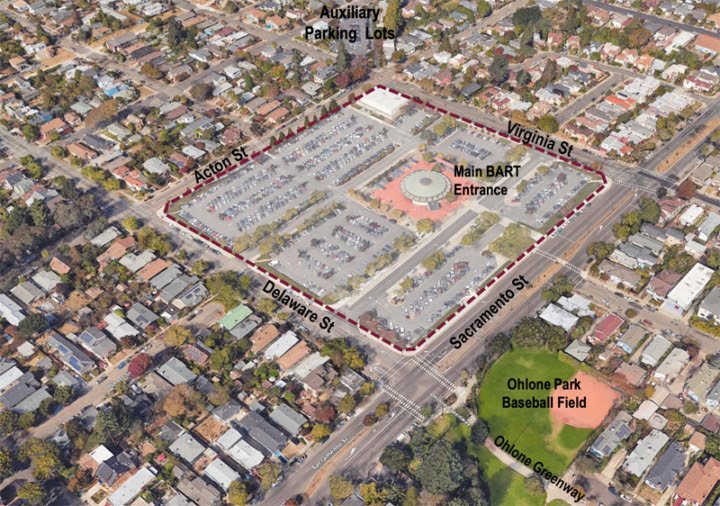Affordable Housing on Track at Ashby and North Berkeley BART
Developing housing at the Ashby and North Berkeley BART stations is a once in a generation opportunity. These two sites represent the best opportunity to achieve the most affordable housing. With Berkeley’s population having increased by ten percent over the last decade, the reality is more housing is needed to accommodate this growing population and address the housing needs of people who live and work here now. As we face a severe climate crisis, the most environmentally friendly way to develop housing is to have transit oriented development, reducing reliance on motor vehicles, with transportation accounting for 60% of the city’s greenhouse gas emissions.
When BART was first constructed over 50 years ago, it tore apart many neighborhoods throughout the region. Eminent domain was invoked to buy whole blocks of homes, and housing and businesses were destroyed and people displaced. In Berkeley, community activism led to the undergrounding of the BART tracks in Berkeley to minimize physical and economic segregation. Despite these efforts, homes were still destroyed and neighborhoods, especially along the predominantly African American community in South Berkeley, were severely impacted. Understanding this legacy and those impacts is important in making sure that future development on these sites is equitable and helps remedy those adverse impacts. That is why increasing the number of truly affordable homes is essential at these two sites. Through the Adeline Corridor Plan, we have committed to an aspirational goal of 100% affordability at Ashby Station and local preference policy allowing prioritizing previously displaced residents for new low-income housing.
Future development at these sites will also be key in meeting our RHNA goals, a state mandate that requires Berkeley to build almost 9,000 units of housing across all levels of affordability over the next eight years. Ultimately, we will make sure that a community-based vision for the future of these two important sites is fulfilled.
How Did We Get Here?
In 2015, the City of Berkeley began a community planning process to develop a long-range plan for the Adeline Corridor, which includes the Ashby BART Station area. The planning process explored the potential for new transit oriented development on the east and west parking lots at Ashby BART. In March 2018, around 400 people showed up for an initial community meeting hosted by Mayor Arreguin, BART Board Director Rebecca Saltzman and former Councilmember Linda Maio to discuss a new future for North Berkeley BART, including new housing.
In September 2018, a new state law, AB 2923, was approved, creating zoning standards for BART-owned property within a half mile of BART stations. Under AB 2923, jurisdictions must adopt zoning requirements consistent with BART’s Transit Oriented Development standards. For Ashby and North Berkeley, the State-imposed standards are construction of buildings with a minimum height of seven stories, a minimum density of 75 units per acre, and a Floor Area Ratio (FAR) of at least 4.2. This would create approximately 1,200 units per station. In 2019, after a community design workshop and public input, the Council adopted high level goals for the development of the North Berkeley BART station parking lots.
In March 2020, the City and BART established a Memorandum of Understanding (MOU), which set out the timeline for pre-development. Over the last couple of years, City staff have been working with BART in achieving the goals set out in the MOU. An important aspect of this is community outreach and input. In 2020, the Community Advisory Group (CAG) was established with the goal of drawing broad community participation and providing valuable input to the Planning Commission as it considers zoning standards that will be consistent with the City’s obligations under AB 2923 for the Ashby and North Berkeley BART station areas. Members of the CAG were appointed with an eye toward ensuring a diversity of views, perspectives, and experiences, including: representing all geographic areas of the city on which station area development would have an impact such as immediate as well as commuter neighborhoods; reflecting a wide-range of relevant expertise in areas such as city planning, architecture, transit, and environmental sustainability; and incorporating diverse life experiences. The CAG held eight community meetings between June 2020 and December 2021.
In April 2022, the Berkeley Planning Commission, in a split 5-4 vote, recommended a 12 story base height for Ashby and North Berkeley along with other new zoning standards. City staff had recommended a 7 story height limit, which had been vetted through the draft environmental impact review. Both the Planning Commission and city staff recommendations were presented to City Council at a public hearing last Thursday, June 2, 2022.
What Action Was Taken?
Shortly after midnight on Friday, June 3rd, the City Council unanimously adopted new zoning regulations for the Ashby and North Berkeley BART stations. The Council approved a maximum base height of 7 stories and a minimum of 75 dwelling units per acre as recommended by city staff. In addition to adoption of zoning, the Council certified the Environmental Impact Report for the BART zoning project, approved a new Memorandum of Agreement with BART outlining the next steps of the process, and a Joint BART-City Vision and Priorities (JVP) Document. The BART Board of Directors will consider the new Memorandum of Agreement and JVP at its meeting on Thursday, June 9th.
The action was intended to implement the zoning standards set forth in AB 2923, with a height limit of seven stories with a total of 2,400 units. However, under state law a developer may be eligible for a density bonus resulting in a final height of 12 stories and a total of 3,600 units. The density bonus can only be triggered based on the amount of affordable housing built; the more affordable housing, the denser the project can be. A critical next step in the process is the development of objective design standards which the city will create and adopt to regulate building form. This will ensure that the ultimate development is not a massive block but is articulated to achieve good design, context and increase light, air and open space.
Next Steps
There are no proposed projects at this time. Any rendering of developments that have been distributed are purely fictional, and are not accurate representations of any future development. The next steps will include sending out a Request for Qualifications (RFQ) for developer selection, and the BART Board selecting a developer team at the end of 2022 or early 2023. In addition, the Council will be working with BART to address critical issues relating to the Ashby BART development including the city’s option of the air rights at the Ashby West Parking Lot and the future location of the Berkeley Flea Market. It is expected that the City Council will approve an amendment to the BART MOA this fall along with a decision on the air rights, Ashby Flea Market location and a proposed road reconfiguration of Adeline Street near Ashby station. In addition, the City will be developing a parking management strategy to address parking impacts at both BART stations.
Over the next 18 months, objective design standards will be developed and adopted. A developer will likely be chosen in 2023, with project approval and entitlement after. Construction would begin as early as 2025, once financing is secured.
While last week’s vote was a significant milestone in this lengthy process, there still is plenty of work to be done. As we have done in the past, we will continue to shape the vision of the future of Ashby and North Berkeley BART through our progressive values and input from the community. These new developments must maximize affordability and help heal the scars caused by the original development of the BART system. I look forward to continuing working with you in this process over the next couple of years in creating a development of which we can all be proud of.


